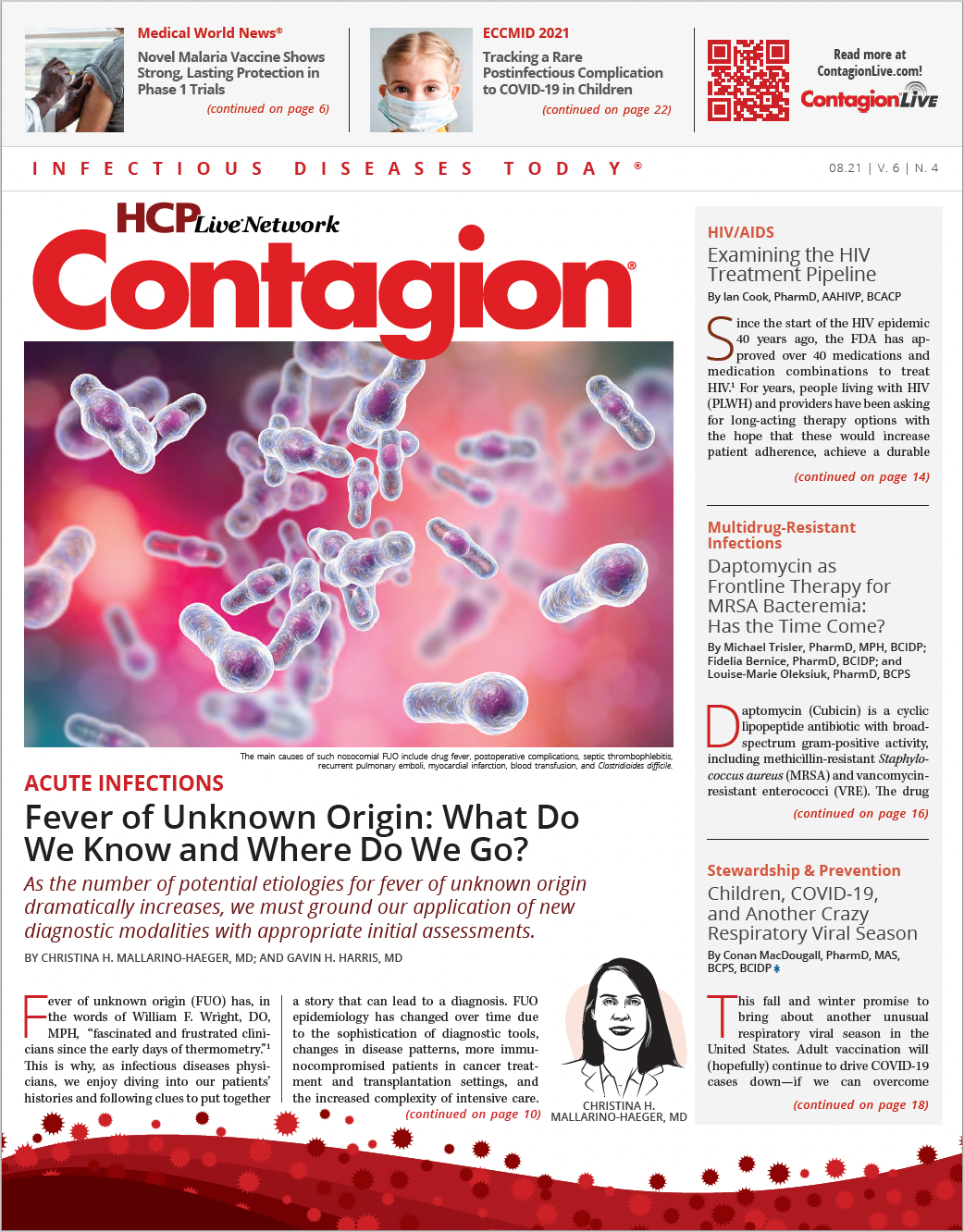Mono or Combo? Exploring the Role of Combination Antimicrobial Therapies for Invasive Carbapenem-Resistant Gram-Negative Infections

New agents to combat multidrug-resistant gram-negative (MDRGN) organisms are sorely needed.1 A modicum of reassurance can be found in a number of new compounds that have been developed in recent years and incorporated into updated Infectious Diseases Society of America guidelines, including novel β lactam-β lactamase inhibitors (βL- βLIs), tetracyclines, and a first-in-class siderophore antimicrobial, cefiderocol.2 Although a precise niche for each remains to be determined, combination therapies continue to be employed for treatment infection from MDRGN organisms, based on a theoretical advantage of augmented bacterial killing and preservation of susceptibility to individual drug classes. Randomized trial data are limited and have shown improved microbiological eradication but similar clinical outcomes.3
Carbapenem-resistant GN bacilli (CR-GNB), broadly including species within the order Enterobacterales and certain lactose nonfermenters (Acinetobacter, Pseudomonas), are among the most problematic and novel treatments that have been prioritized by the World Health Organization.4 Scudeller and colleagues recently described in vitro data of bacterial killing and antibiotic synergism, part of the broader COHERENCE (COmbination tHErapy to treat sepsis due to carbapenem-Resistant bacteria in adult and paediatric populations: EvideNCE and common practice) Project, a global collaboration examining combination therapies for CR-GNB.4 The study included various antibiotic combinations and dosages against CR-GNB from time kill (TK) and pharmacokinetic/pharmacodynamic (PK/PD) studies, chosen for their standardized methods and reproducibility, and their ability to recapitulate drug exposure in vivo, respectively.
All articles published through 2018 within the PubMed and Scopus databases and the Web of Science platform were eligible. Reviews, editorials, and protocol papers were excluded, as were publications examining single bacterial strains. Two investigators reviewed relevant studies for eligibility, with a third acting as a tie-breaker. Study quality was assessed on a 0 to 18-point scale, and studies with more than 11 points were deemed high quality and warranting sensitivity analysis. Relevance was categorized as reliable without restrictions, reliable with restrictions, not reliable, or not assignable.
The primary outcome was in vitro synergy or antagonism (defined as a >2-log reduction or increase, respectively, in colony-forming unit [CFU]/mL vs most active single agent) and was stratified by effect size (high, moderate, low, or absent). Secondary outcomes included bactericidal rates (a >3-log reduction in CFU/mL from baseline) and regrowth rate (a ≥2-log CFU/mL decrease of initial colony count, followed by an increase of ≥1-log CFU/mL at 12 and 24 hours). Resistance was determined according to European Committee on Antimicrobial Susceptibility Testing 2019 break points.
From nearly 7000 publications, 797 were assessed for eligibility and 136 included in the meta-analysis. Of these, 31% (42/136) reported PK/PD data, 69% (94/136) reported TK data, and 7% (10/136) reported both. 182 antimicrobial combinations were tested in TK studies and 41 in PK/PD studies. The vast majority involved 2-drug regimens, most commonly colistin- and carbapenem-based. Of 136 studies, 73 (54%) were deemed high quality.
For A baumannii, high synergy was observed with meropenem plus polymyxin/colistin, tigecycline plus colistin, rifampicin plus colistin, and imipenem plus tobramycin. On sensitivity analysis, 4 high-quality TK studies confirmed synergy with carbapenem plus polymyxin, and high synergy was observed with imipenem plus tobramycin and TMP/SMX plus colistin. With respect to secondary outcomes, of 29 polymyxin- and doripenem-based combinations, the authors observed no significant differences in bactericidal activity or regrowth rates vs monotherapy.
For P aeruginosa, moderate synergy was seen with combinations of ceftolozane/tazobactam plus colistin, imipenem plus colistin, meropenem plus amikacin, meropenem plus colistin, imipenem plus tobramycin, and doripenem plus colistin; high synergy was seen with imipenem plus amikacin. Sensitivity analysis revealed moderate synergy with combinations involving doripenem/imipenem plus colistin from 2 PK/PD studies and 1 TK study. For secondary outcomes, 6 combinations showed significantly higher bactericidal rates with combinations of meropenem plus amikacin, or imipenem plus amikacin/tobramycin vs monotherapy, and significantly less regrowth at 24 hours with imipenem plus amikacin/tobramycin vs monotherapy.
For K pneumoniae, high synergy was observed with combinations of rifampicin plus colistin, imipenem/doripenem plus polymyxin B, imipenem/meropenem plus amikacin, ceftazidime/avibactam plus aztreonam, and fosfomycin plus polymixin B. Sensitivity analysis revealed moderate to high synergy for combinations of fosfomycin plus polymixin, rifampicin plus polymyxin, and a carbapenem plus polymyxin. In 39 combination regimens from TK and PK/PD studies that were examined for secondary outcomes, investigators found that polymyxin-based combinations (with rifampicin or gentamicin) had significantly higher bactericidal rates vs monotherapy, and significantly lower regrowth at 12 and 24 hours vs monotherapy.
This was the largest systematic review and meta-analysis to date of in vitro data of combination therapy vs monotherapy for CR-GNB that examined multiple pathogens and a prolific number of regimens (>180). Compared to monotherapy, the authors found high synergy and increased bactericidal activity for A baumannii; high synergy, increased bactericidal activity, and lower regrowth for K pneumoniae with polymyxin-based regimens; and high synergy, high bactericidal activity, and lower regrowth for P aeruginosa with a carbapenem and an aminoglycoside. Limitations included scant high-quality data for combinations involving novel compounds, heterogeneity in the combinations studied, regrowth assessment limited to 24 hours, and limited generalizability due to the variability of bacterial strains and resistance patterns. Additionally, the lack of in vivo correlates limits one’s ability to translate these findings into clinical practice.
Although the results do not address who should be treated with combination therapy, the authors should be commended on their appraisal of the literature. Despite their findings, it is incumbent upon infectious diseases practitioners to exercise caution with polymyxin-based regimens, which is underscored by the updated Clinical and Laboratory Standards Institute breakpoints listing only “intermediate” and “resistant” categories for Enterobacterales.5 These data, though intriguing, perhaps best serve to stimulate subsequent human trials of the most promising regimens identified to combat the rising tide of MDRGN infections.
Sean S. M. Bullis, MD, is an infectious diseases fellow at the University of Vermont Medical Center in Burlington.
Andrew J. Hale, MD, is an infectious disease physician at the University of Vermont Medical Center and an assistant professor of medicine at Larner College of Medicine at the University of Vermont in Burlington.
References
- Boucher HW, Talbot GH, Bradley JS, et al. Bad bugs, no drugs: no ESKAPE! An update from the Infectious Diseases Society of America. Clin Infect Dis. 2009;48(1):1-12. doi:10.1086/595011
- Tamma PD, Aitken SL, Bonomo RA, Mathers AJ, van Duin D, Clancy CJ. Infectious Diseases Society of America Guidance on the Treatment of Extended-Spectrum β-lactamase Producing Enterobacterales (ESBL-E), Carbapenem-Resistant Enterobacterales (CRE), and Pseudomonas aeruginosa with Difficult-to-Treat Resistance (DTR-P. aeruginosa). Clin Infect Dis. 2021;72(7):e169-e183. doi:10.1093/cid/ciaa1478
- Durante-Mangoni E, Signoriello G, Andini R, et al. Colistin and rifampicin compared with colistin alone for the treatment of serious infections due to extensively drug-resistant Acinetobacter baumannii: a multicenter, randomized clinical trial. Clin Infect Dis. 2013;57(3):349-358. doi:10.1093/cid/cit253
- Scudeller L, Righi E, Chiamenti M, et al. Systematic review and meta-analysis of in vitro efficacy of antibiotic combination therapy against carbapenem-resistant Gram-negative bacilli. Int J Antimicrob Agents. 2021;57(5):106344. doi:10.1016/j.ijantimicag.2021.106344
- CLSI. M100: Performance Standards for Antimicrobial Susceptibility Testing. 30th ed. Clinical and Laboratory Standards Institute; 2020.

